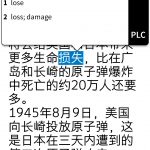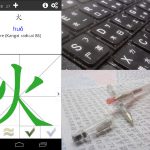Articles tagged with ‘Pleco’ Page 2
-
How to look up Chinese characters you don’t know
Looking up an unknown character in Chinese is much trickier than looking up unknown words in most other languages. This article discusses various ways of looking up Chinese characters, including paper dictionaries, handwriting input, OCR and more.
Read → -
Looking up how to use words in Chinese the right way
Looking up how to express something in Chinese is not as easy as it looks. Assuming that a word, especially a verb, can be used the same way in Chinese as in your native language usually results in incorrect or awkward sentences. Stop assuming and look things up properly instead!
Read → -
Zooming out: The resources you need to put Chinese in context
In order to learn efficiently, it’s important that you integrate your knowledge. This means being able to break down Chinese in order to understand it, as well as looking at context and sorting out confusing cases. In this second article, I introduce tools for zooming out and putting things in context.
Read → -
Why you should read Chinese on your phone
Reading Chinese in this digital age is a lot easier than it used to, but it’s actually even easier than many students think. The benefits of reading on your phone are important, including instant access to vocabulary, smaller chunks of text, portability and a sense of getting somewhere when you read. If you haven’t read a Chinese text on your phone yet, you really should give it a try.
Read → -
Sensible character challenge, January 11th to 31st
It’s time for the first challenge of 2015! I have a feeling I’m not the only one who has fallen behind on vocabulary learning and reviewing, so this month’s challenge will focus on learning and characters and words. There are prizes on offer and the challenge starts on the Sunday 11th.
Read → -
7 ways of learning to write Chinese characters
There are many ways of practising writing Chinese characters and they all have their pros and cons. In this article, I discuss seven different ways of practising and what advantages and disadvantages they have for you as a learner. Which do you use?
Read → -
Sensible character learning challenge 2014: Milestone #1
The first milestone in the 2014 sensible character learning challenge has now been reached! This is a good opportunity to join the challenge if you haven’t already, and if you have, it’s time to report how the first few weeks have gone. This article also contains information about prizes (character posters, free extensions and promo codes) for the first milestone, as well as my own reflections of my character learning.
Read → -
Sensible Chinese character learning challenge 2014
The 2014 sensible Chinese character learning challenge starts soon! This article introduces the challenge and how you join us. Apart from learning a lot of characters and improving the way you learn characters, you also get a discount and free extensions on Skritter, as well as a chance of winning character posters from Hanzi WallChart!
Read → -
Sensible Chinese character learning revisited
In a way, learning Chinese characters is very much like learning vocabulary in any foreign language and much of the efficient methods developed there works well for Chinese as well. However, characters are also fundamentally different from words in English and this influences how we should learn them as well. This article is a recap of how to learn Chinese characters in a sensible way. It is also a prologue for the upcoming character learning challenge.
Read → -
21 essential dictionaries and corpora for learning Chinese
There are many online resources for looking up Chinese characters and words, so many that it might be very hard for new learners to find what they need. This article introduces 21 dictionaries and corpora for Chinese learners, including what they should be used for in addition to some pros and cons.
Read →





